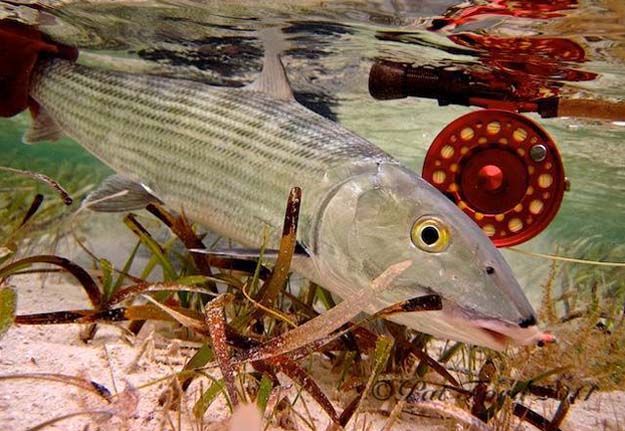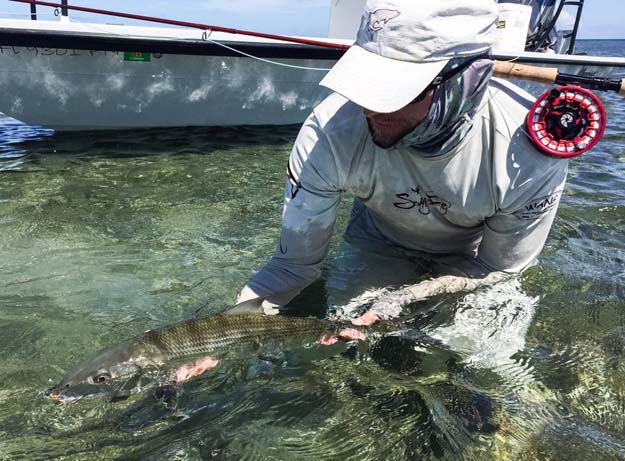[dropcap]J[/dropcap]oan Wulff, one of the most famous ambassadors of our fly fishing sport wrote New Fly-Casting Techniques in 2012. In it, she describes the life-cycle of a fly fishing addict. She says there are three distinct morphing stages. One, wanting to catch lots of fish; two, only big fish, and finally what she calls “the spinner-like stage” where only a certain species provides the meridian. Bonefish are that for lots of folks and hundreds of reasons.
The final stage
This advanced stage manifests itself with the angler becoming a species biologist, tuned into tide and moon phases and developing a one-with understanding about bonefish body language. The latter especially relevant in the spooky bonefish aggregations found in the Florida Keys, Biscayne Bay, the Bahamas, Caribbean, Belize, Mexico, Los Roques, Hawaii, Seychelles – you guessed it; anywhere.
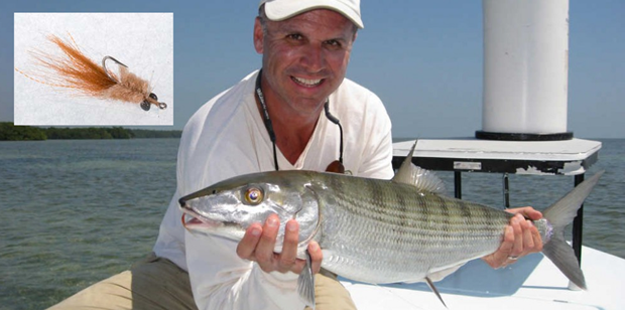
Tim Mahaffey with an Islamorada double digit bone. Duane Baker’s crab fly (insert) reportedly travels well. Photo by Pat Ford – click on the image to visit his website.
A difference of opinion
Tournament caliber bonefish experts like Sandy Moret, Tim Mahaffey, Chico Fernandez and many, many guides in both the Florida Keys and the Bahamas have opined on the matter of catching Mr. Bone. Not so oddly, their choices in rod actions, rod weights, fly lines, and leaders and materials don’t always line up with each other.
Also, that would be casting techniques, the entirety of equipment preferences (hats to wading shoes), rigging and fly choices. However, one thing is a cappella when bonefishing with any top angler – go with a very, very experienced guide. In many cases, you will hear a professional guide saying that. He or she knows better if not fishing their turf.
There are a few other all-in shout outs, and one of those is fly choices because worldwide a bonefish stomach will contain crabs. Yes, shrimp are high on crustacean list as well, but in the stomach of a bonefish, the content of crabs will outnumber shrimps.
Fly rods
A big part of the inconsistency with these highly skilled anglers was armament – fly rods. Almost all interviewees personally use one stick manufacturer for their choices in all weights carried. Most of these anglers owned hi-end rods – many with older models. Some as old as ten years old. Their sticks were like pet dogs.
Oddly, the weight preferences for bones wasn’t always the obvious 8-, 9-weight. One Keys guide is distinguishing himself by preferring a 6-weight when pursuing bones. No one ventured “Back to the Future” with fiberglass, switch rods never drew a straw nor did shorter than 9-feet or longer than 9-feet.
The rationale for using just one-rod manufacturer (model), as explained by Mahaffey, is that if you go from 7- to a 9-weight the actions will be same. No need to adjust to a slower or faster action. For tournament anglers or any angler, that translates to no lost seconds or a minute re-familiarizing with the action of a different rod action with false casts. That bone or poon will not wait on you to “get right.”
Consummate bonefish tournament winner Tim Mahaffey added a point about rod buying. “The choices for rods are mind boggling, and spending $850 isn’t necessary. Remember, most manufacturers’ second or third rated rod was their premium rod five years ago.”
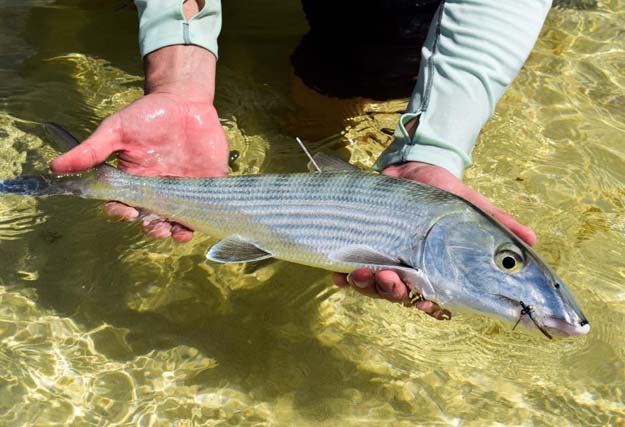
Bahamian bone tagged, fin clipped and released. Tagging provides valuable information on habitat, spawning locations and recorded distances traveled to spawn. BTT image.
Reels – sustaining the ability to brawl
Reels owned the same distinction – only one reel maker for all rod weights. Each, of course, preferential to different reel makers. The top of the list was Tibor followed by Nautilus, and then it fell off the cliff. Our advertiser, 3-Tand hung in there.
Yes, some were using reels from manufacturers they represented. However, all owned durable, large arbor reels with sealed drags. Drags, it was collectively pointed out, need to be smooth since even a 3-pound bone will test your 12-pound tippet with their signature head shakes and bursts. No one seemed interested in buying downgrade when it came to reels. They all agreed that a reel had to be built for a lifetime of hard living.
The “Kumbayah” of your rod and fly line are crucial
The choosing of a fly line along with leaders seemed to draw quite a bit of ideological fervor. The knowing of its importance, telling.
A fly line is first-responder to a fly rod and anglers’ casting success – distance and accuracy the currency. If you were to ask any serious angler what is more important, the fly line or the rod? He or she would not hesitate with the answer. The fly line. The thinking there is you can adjust to a rod’s action, but if the fly line can’t shoot through the guides properly or in the wind, sink, float or carry a small, intermediate or big, bushy fly then you have an irreconcilable problem.
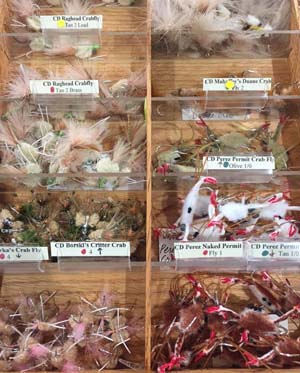
Nuttin’ but the top flats guides and world class tyers crab patterns at Reed’s shop – Chris Dean, Dale Perez, Bob Branham, Tim Borski, Duane Baker, Mark Krowka, and the owner of the shop, Don Reed. Photo credit Luke Blaser.
Factors to be considered when buying a fly line or fly lines for bones
You’ll want a tropical line and prepare for windy conditions. Can the line pitch different size flies? And the toughest question to be answered: What is your skill level? Paying attention to the latter is important because the distance you can cast dictates the line you’ll need. That boils down to, basically, matching the line’s head length to your typical fishing distances.
The longer heads are best for long casts, but that comes with a caveat – false casts. Then there’s the conundrum of OPST, which no one bit on. It’s advantage not yet determined in the salt world, but here goes. Its troutser negatives are that its short head is not good for soft, dry fly landings or drifts.
Okay, we don’t have that problem in the salt. No, that does not mean it’s going to work out fine with a rock-like landing, but a feather landing with a weighted crab pattern is not going to waft through the air like a 28 anything and land like an Adams. So, throw that BS away. A Commando Head and Lazur line have real advantages (Google for more information).
Leaders
The subject of leaders can erupt into a jihad – so to avoid backlash, here’s a short excerpt about that by bonefish Guru Chico Fernandez – from his book chapter titled The Right Material:
“I feel strongly about the use of standard-flex leader material. Very stiff material produces terrible knots, and the fly will not swim naturally. The Very supple material gives you little turnover power and more wind knots. You want a compromise between the two. Many manufacturers offer appropriate monofilaments.
There is an alternative to all this, and that is knotless leaders like the ones you may use in fresh water. While they have improved in the last few years, they are still too soft for me, particularly in the warm environments where we find bonefish. And the butt sections are usually too short, especially once you have used part of it to tie to the fly line. When you have changed flies a few times or broken a tippet on a fish, you have to add tippet material to your knotless leader; if you know how to tie a blood-knot to repair a leader, then you know how to build one from scratch, with good material.”

Bottom row: Dale Perez’s Permit Crab (olive, naked and tan). Second row: Branham’s Epoxy Crab, Raghead Crab, Merkin; Borski’s Critter Crab, Krowka’s Crab, and Mahaffey’s Duane Crab. Luke Blaser photo – click on the image to visit SWFT website.
The take-home short list thoughts on flies from Mr. Bonefish
Tim Mahaffey:
“For targeting giant bonefish, I fish only three fly crab patterns. One, the brown Merkin; two, brown Duane Crab (toad), and three, the Red Headed Step Child (reddish brown colored Gotcha crab that I use for catching smaller, ‘release’ bones).”
NOTE:
1. The flies are tied on size 1- or 2 Mustad 3407s.
2. Color doesn’t matter, as long as it is brown.
3. The primary concern for fly selection is the weight of the fly.
Tying fish catching crab patterns is the trickiest game for the flats
A skilled tyer – even an intermediate level fly tyer can tie a crab pattern given the recipe and steps, BUT the trick with crabs is how they swim/ambulate in the water. If it spins, head-over-heels downward, spiral dives to the benthic floor you’ll be the proud owner of misspent time and money. Our editorial staff ties, but ALL their crab patterns are bought from select shops and specific tyers.
Probably the best-known pattern is the Merkin, named by Del Brown who spent a lifetime chasing permit. Jefferey Cardenas, former Key West guide, author, adventurer and former fly shop entrepreneur won the one fly only tournament in the Keys using a Merkin with the legs removed.
Chris Dean’s crab patterns are a favorite in South Florida, Bahamas, Yucatan, and Belize, especially for permit and bonefish. Anyone not taking a slew of various sized and different colored crab patterns on an outing that target anything from tarpon to cobia would have to be considered profligate.
Hit it on the head says, Mahaffey
When using a crab pattern, the trick is not to let the red, bone or especially a permit have a chance to examine (discover) the fly because the rejection rate is high. Hit the thing on the head; you’ll have a far higher batting average. When schooled and running in 4- to 5-feet of water, the same methodology applies. Hit it them on the head.
Sourcing flies: Foreign online beware
If you do not tie your own, the best sources for crab patterns are fly shop owners, and their employees with considerable flats fly fishing experience or fly tyers with reputations for tying flats type flies. Well known fly shops (see information below) and industry suppliers like Umpqua and others can be reliable.
The Fish Hawk . . . (Gary Merriman and Chad Brown – great anglers and knowledgeable)
Saltwater Fly Tyers/Oyster Creek Outfitters. . . (Don Reed – experienced flats angler and world-class fly tyer – carries Dean’s flies)
Florida Keys Outfitters . . . (Sandy Moret, Drew Moret, Mike Duckworth – experienced flats and bonefish anglers)
NOTE: Featured Image is by professional photographer Pat Ford. He reminds us that you don’t always need expensive equipment to take great photos – underwater point and shoot cameras can get the job done. BTT photo library.


